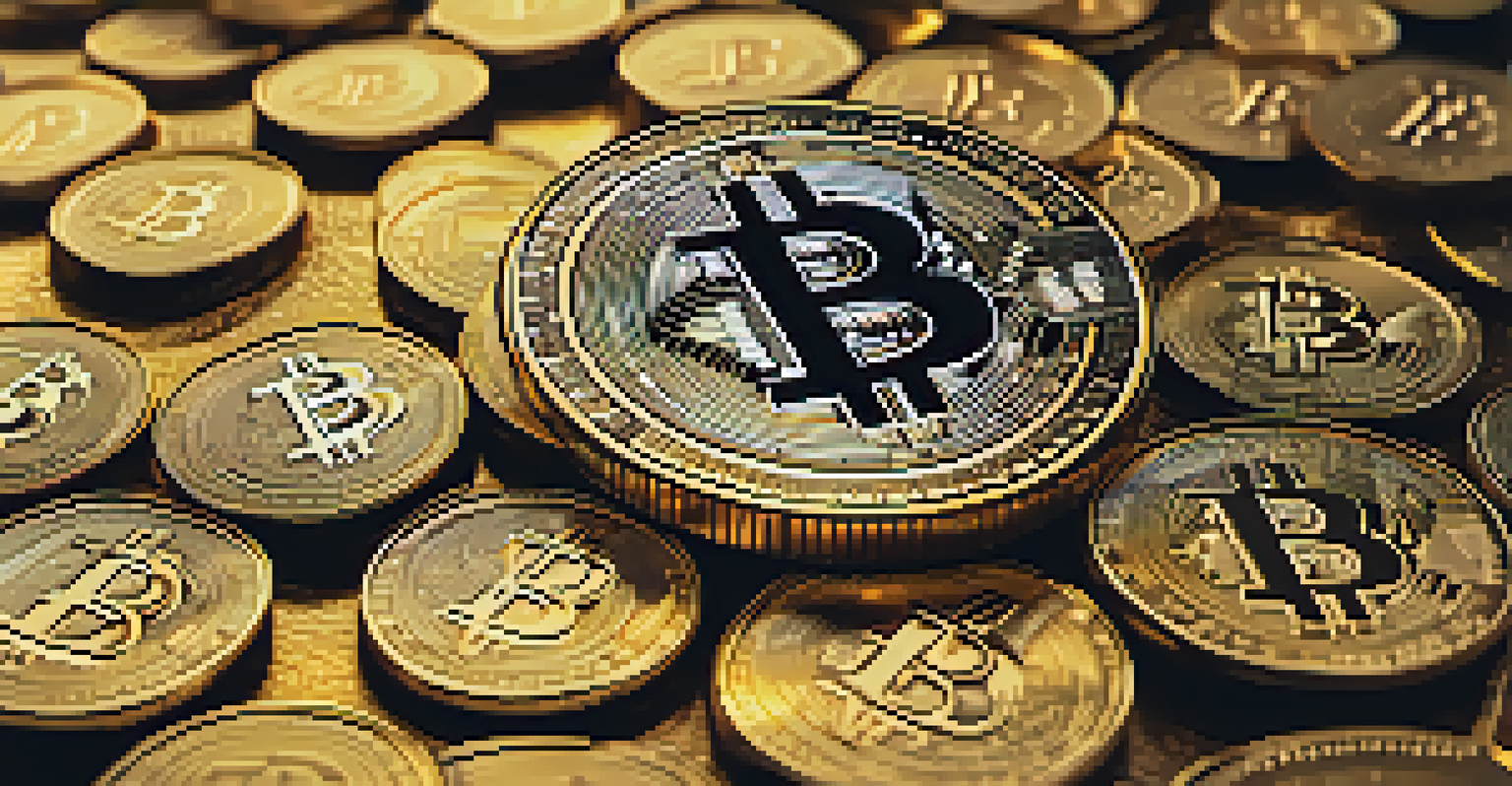The Evolution of Money: Bitcoin as Digital Gold

Tracing the Origins of Money Through History
The concept of money has evolved dramatically over centuries, starting from barter systems where goods were exchanged directly. As societies grew, the need for a more efficient medium became apparent, leading to the use of commodities like gold and silver. These tangible forms of money provided intrinsic value and were widely accepted across cultures, paving the way for standardized currency.
Bitcoin is a technological tour de force.
Over time, paper money emerged, making transactions more convenient and allowing economies to grow on a larger scale. With the advent of technology, digital transactions began to take shape, further revolutionizing how we perceive money. However, the transition to digital forms left many wondering if anything could replicate the value and trust historically associated with gold.
This brings us to the 21st century, where Bitcoin first appeared in 2009 as a radical new form of currency. Bitcoin was designed to overcome the limitations of traditional money, offering an innovative decentralized system that not only provides a medium of exchange but also challenges the very notion of what money can be.
Understanding Bitcoin: The Basics You Need to Know
Bitcoin is a cryptocurrency, which means it relies on cryptography for secure transactions and control of new units. Unlike traditional currencies issued by governments, Bitcoin operates on a peer-to-peer network, meaning transactions occur directly between users without intermediaries. This decentralization is one of its core strengths, as it reduces the risk of manipulation by central authorities.

The Bitcoin network is built on blockchain technology, a transparent and immutable ledger that records all transactions. Each transaction is verified by network participants, known as miners, who solve complex mathematical problems to secure the network. This process not only adds new bitcoins into circulation but also ensures the integrity of the entire system.
Money's Evolution Toward Digital Forms
The transition from bartering to digital currencies like Bitcoin illustrates the significant evolution of money over time.
Understanding Bitcoin involves recognizing its potential as both a currency and an asset. Many view it as a speculative investment, while others see its utility in everyday transactions, especially in regions with unstable currencies. This dual nature is what often leads to discussions about Bitcoin as 'digital gold.'
Why Bitcoin is Often Compared to Gold
The comparison between Bitcoin and gold arises from their shared characteristics, particularly their scarcity and value preservation. Just as gold is limited in supply, Bitcoin has a capped maximum of 21 million coins that can ever exist, making it a deflationary asset. This scarcity is a key reason why many investors consider Bitcoin a hedge against inflation, similar to the way they would with gold.
The future of money is digital currency.
Gold has been used for centuries as a store of value, and Bitcoin is increasingly being recognized for its potential to serve the same purpose in our digital age. The idea is that during times of economic uncertainty, both assets can retain their value better than fiat currencies, which can be printed in unlimited quantities by governments. This perspective is gaining traction, especially among younger investors who are more comfortable with digital assets.
Furthermore, Bitcoin's portability and ease of transfer add to its appeal. Unlike gold, which can be heavy and cumbersome to transport, Bitcoin can be sent across the globe in minutes with minimal fees. This unique combination of scarcity, portability, and security solidifies its status as 'digital gold' in the minds of many.
Bitcoin's Role in Modern Financial Systems
As Bitcoin continues to gain acceptance, it's reshaping the landscape of modern financial systems. Many institutions are now exploring how to integrate cryptocurrencies into their services, from investment options to payment solutions. This shift reflects a growing recognition of Bitcoin's potential to coexist with traditional finance, rather than completely replace it.
Some companies are even beginning to hold Bitcoin on their balance sheets, viewing it as a strategic asset that can provide long-term value. This trend signifies a broader acceptance of digital currencies and highlights the changing attitudes towards what constitutes a legitimate form of money. Additionally, Bitcoin's rise has sparked discussions about regulatory frameworks and how governments will respond to this new asset class.
Bitcoin's Dual Role as Currency and Asset
Bitcoin serves not only as a medium of exchange but also as a speculative asset, often compared to gold for its scarcity and value preservation.
Moreover, Bitcoin has inspired the growth of a whole ecosystem of cryptocurrencies and blockchain technologies, each offering unique features and use cases. This innovation is pushing the boundaries of what financial systems can achieve, making transactions faster, cheaper, and more secure.
Challenges and Criticisms Facing Bitcoin
Despite its potential, Bitcoin faces several challenges and criticisms that can hinder its widespread adoption. One major concern is its price volatility, which can make it a risky investment. Unlike traditional currencies, Bitcoin's value can fluctuate dramatically over short periods, creating uncertainty for those looking to use it as a stable form of payment.
Additionally, Bitcoin has been criticized for its environmental impact due to the energy-intensive mining process. The growing concern over carbon footprints has led to debates about the sustainability of cryptocurrencies. Some advocates argue that solutions like renewable energy sources for mining could mitigate these issues, while others call for a more significant rethink of how cryptocurrencies are produced.
Lastly, regulatory challenges are ever-present, as governments worldwide grapple with how to classify and regulate Bitcoin. This uncertainty can stifle innovation and deter potential investors. However, as the ecosystem matures, it’s likely that clearer regulations will emerge, paving the way for a more secure environment for Bitcoin to thrive.
The Future: Will Bitcoin Solidify Its Status as Digital Gold?
Looking ahead, the future of Bitcoin as a form of digital gold remains a topic of much speculation. As more individuals and institutions adopt Bitcoin, its role in the global economy could become more pronounced. The ongoing development of technology and infrastructure around Bitcoin will play a crucial role in determining whether it can achieve this status.
Factors such as increased regulatory clarity, mainstream acceptance, and technological advancements will significantly influence Bitcoin's trajectory. Additionally, as new generations of investors enter the market, their perspectives on value and investment may further solidify Bitcoin's position as a digital asset. This shift could lead to broader acceptance as a legitimate form of currency and store of value.
Challenges Bitcoin Faces Ahead
Despite its potential, Bitcoin grapples with issues like price volatility, environmental concerns, and regulatory uncertainties that could hinder its adoption.
Ultimately, whether Bitcoin will fully cement its reputation as digital gold will depend on various external factors, including economic conditions, technological innovations, and societal attitudes towards money. The journey of Bitcoin is far from over, and its evolution could reshape our understanding of wealth in the digital age.
Conclusion: Embracing the Evolution of Money
In conclusion, the evolution of money has brought us to an exciting juncture with Bitcoin at the forefront. As we’ve explored, Bitcoin's journey mirrors that of gold in many ways while also diverging into new territories that challenge traditional norms. Its potential to function as both a currency and an asset poses intriguing possibilities for the future of financial transactions.
As society continues to adapt to an increasingly digital landscape, embracing innovations like Bitcoin could redefine our understanding of value and exchange. While challenges remain, the resilience and adaptability of Bitcoin's community suggest that it may find its place in the world's financial ecosystem.

Ultimately, the evolution of money is a reflection of human creativity and ingenuity. Just as we have transitioned from barter to coins, and from paper to digital transactions, Bitcoin stands as a testament to our ability to innovate and adapt in the face of change.